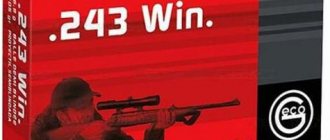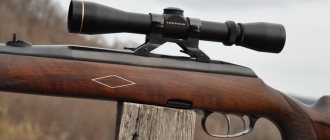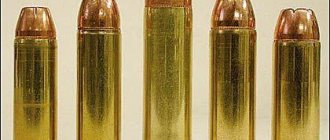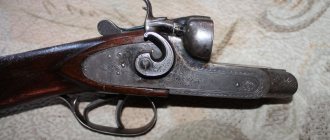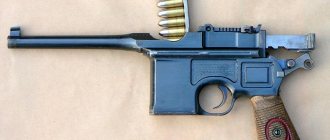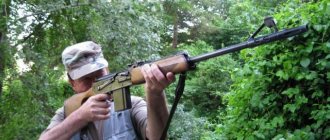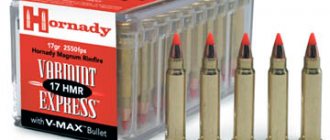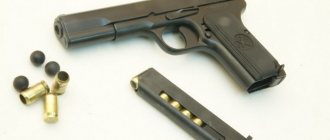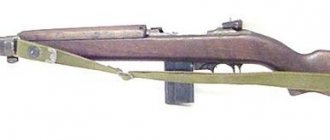Cartridge 9.3×64
| 9.3×64 Brenneke |
The 9.3x64mm cartridge was developed by German designer Wilhelm Brenneke around 1910 for the Mauser bolt-action repeating rifle.
This cartridge was originally created as a hunting ammunition. It had an additional power reserve compared to the 9.3x62 cartridge, which made it possible to use it to kill not only all large animals in Europe and North America, but also most representatives of the African fauna.
9.3×64 Brenneke
The 9.3×64 Brenneke cartridge was recommended for hunting Kamchatka and Far Eastern bears, as well as bears of the northwest of the North American continent and all subspecies of moose, including the largest ones from the northeast of Siberia. In addition, it was used to shoot most African antelopes weighing up to 600 kg and lions.
Initially, in pre-war times, the 9.3x64 Brenneke was manufactured by the German company DWM (company catalog number 567), and it was popular only among a fairly narrow circle of high-ranking German hunters with a weakness for hunting big game and safari enthusiasts.
However, soon, along with the English .375 H&H, it became the most powerful cartridge in Europe from the nine-millimeter group. The English .369 Purdey, which was similar in power and appeared in 1922, could not supplant it on the market.
The production of the 9.3×64 cartridge was established mainly in Germany.
In the second half of the twentieth century, it began to be produced in the USA, in particular by the American company A-Square. 9.3×64 Brenneke
The 9.3×64 Brenneke cartridge has a bottle-shaped case with a groove.
It is equipped with expansive bullets of various designs, including KS, TMR, TUG, weighing 16.0, 18.5, 19.0 g, with an initial velocity and muzzle energy of 850, 820, 785 m/s and 5780, 6220, 5857 J, respectively. The speed of these bullets and energy respectively at a distance: 100 m – 755, 695, 720 m/s and 4560, 4464, 4925 J, 200 m – 670, 605, 670 m/s and 3591, 3384, 4267 J, 300 m – 585, 540, 625 m/s and 2738, 2698, 3708 J.
The optimal zeroing distance is 160 m. The excess of the flight path of a bullet with a mass of 16.0, 18.5, 19.0 g above the aiming line at a zeroing distance of 160 m is 5.5, 6.5, 6.2 cm, respectively.
The 9.3×64 Brenneke cartridge became known with the designations: 9.3×64 Brenneke / 9.2×64 Brenneke / 9.3×63 Hunting Rifle / DWM 567 / SAA 5980 / XCR 09 064 BGC 020.
The production of weapons chambered for this cartridge was launched by many European companies, such as Frankonia, Mauser, Steyr-Mannlicher, etc.
In 1986 M.M. Blum, the son of the famous Soviet designer M.N. Blum, based on the 9.3×64 Brenneke, a Russian hunting cartridge 9.3×64 was developed with a brass sleeve with a non-protruding flange and a semi-jacketed bullet weighing 17.3-17.5 g (initial bullet speed - 740-770 m/s, muzzle energy - 4768-5125 J, pressure – 3340 MPa).
In 1987, a pilot batch of these cartridges was manufactured in Barnaul, but their mass production was mastered much later in Novosibirsk and Barnaul.
If we compare the ballistic characteristics of the Russian cartridge with the characteristics of the German 9.3×64 cartridge, it is easy to see that the Russian cartridge is noticeably inferior in power to its European counterpart. In addition to ballistic characteristics, the Russian version of 9.3x64 differs from those produced abroad by its larger capsule diameter. It has less sensitivity, which, in turn, makes us think about the advisability of using a product of Russian industry in systems manufactured abroad. In Russian weapons, this feature is taken into account already at the stage of designing the trigger mechanism.
This cartridge has found its application in the Russian Los-9 and Tiger-9 carbines.
| 9.3x64 (9СН) |
At the turn of the XX-XXI centuries. The Russian hunting cartridge case served as the basis for the creation of 9-mm sniper ammunition 9.3x64 mm (9SN) for the Russian army.
9.3x64 (9SN)
The 9.3x64 (9SN) sniper cartridge was developed at TsNIITOCHMASH within the framework of the “Burglar” research topic, as a special ammunition for shooting at protected targets at medium distances.
The new cartridge was based on the same old hunting cartridge 9.3×64 Brenneke.
The sniper cartridge 9.3x64 (ind. 7N33) with a brass sleeve is equipped with a bullet with a steel core, weighing 16.6 g, with an initial speed of 785-800 m/s and a muzzle energy of 4920 J. Pressure - 3200-3400 MPa.
This ammunition provides an effective firing range of about 600-800 meters and a high lethal effect against a living target, including those protected by body armor, as well as against light equipment. Penetrating effect of the 9.3x64 (9SN) cartridge - 10 mm armor plate at a distance of 200 m (at least 80%).
In 2006, after passing extensive State tests within the framework of the Burglar R&D, the 9.3x64 (9SN) sniper cartridge was adopted by the Russian army with the self-loading 9-mm sniper rifle SVDK (Sniper Rifle Dragunov Krupnokalibernaya).
MAKSIMOV.SU
Accompanying clients on dangerous hunts requires a lot. And there are special requirements for weapons here - the stakes are sometimes too high.
We will not touch on the topic of African safaris now: we will talk about such complex specifics as Russian trophy hunting.
And to be more precise
— about the weapons of Russian guides. And as an accompanying weapon, let’s consider a rather remarkable, in its ambiguity in user assessments, example of a domestic conversion weapon - the Tiger self-loading carbine.
Straightaway
Let's take it for granted that Russian hunters, incl. – professionals (guides) are traditionally inclined to use domestic carbines, not paying attention to the ease of use, prestige and other constant advertising paraphernalia of foreign weapons.
Reasons
There is a lot to that and they are all objective: the proven reliability of our weapons, its cost, which is more in line with the capabilities of the majority of hunters in Russia, ease of operation and maintenance and, most importantly, the availability and cost of ammunition, spare parts and service (read - the possibility of repairs “on the knee”) .
Finally, a habit.
You never know! Not everyone has access to specialized press, the Internet and television. Or - the desire to even get acquainted with the latest achievements of weapons thought, relying on the very criteria of truth and common sense that they have in abundance.
In this photo and in the two photos below - professional guide A. Emelin with his clients and captured trophy bears
One of
The most important Russian hunt, in fact, which is the personification of hunting in our country, is the brown bear hunt. It is for the giant Russian bears, as well as the corresponding emotions, that foreigners come to us.
However,
catching a large “hairy one” was always extremely valiant in Rus', although, it must be admitted, simpler weapons were used earlier, which somewhat equalized the chances of beast and man. But everything is changing, so we will take the technical perfection of the modern hunter’s equipment as a given of the times.
The largest bears
regularly becoming world champions according to the international Safari Club, live in our Far East: both in Primorye, Kamchatka and the islands - Sakhalin and the Kuril Islands. And all the guides I know are from there. And they all use domestic weapons - “Vepri” and “Tigers”.
Wherein,
having a practical understanding of all models of foreign weapons sold in Russia and abroad. So why do professionals, having the opportunity to buy prestigious imported weapons, prefer to use domestic designs and, what is very important, almost exclusively semi-automatic weapons?
One of
The most famous pro in Russia is Mikhail Kretschmar. He is one of our best bear experts, a hereditary game biologist from Primorye, Ph.D., author of a comprehensive book about bears “The Hairy God” and, what is important for us, the most experienced hunter in the North.
As
escort weapon, his choice is the Vepr-Super-308 carbine. Mikhail has an extremely positive attitude towards domestic semi-automatic conversion machines, incl. - to the “Tigers”, noting their remarkable adequacy to domestic hunting conditions. According to him, if he had not left his work as a guide in the past, he would definitely have purchased a Tiger chambered for 9.3x64.
On Sakhalin
I was lucky to encounter two real masters of bear hunting: in the south of the island - with Oleg Mayamsin, and in the forest-tundra of the North - Andrei Emelin. Both are professionally involved in organizing all kinds of hunting and fishing on Sakhalin, but bear hunting is their passion.
Indicative
weapons of these masters of their craft: Oleg, who uses a Benelli-Raffaello to hunt birds, takes his only carbine to hunt the animal - an ordinary short “Tiger” chambered for 7.62x54R.
Over the past 17 years
he had no complaints either about the reliability of this weapon or its effectiveness: his records were beasts of 450 and 490 kg. Once upon a time, the skull of the first bear received a gold medal at a trophy exhibition in Moscow.
Oleg Mayamsin has been hunting for 17 years with a regular short “Tiger” chambered for a three-line cartridge (7.62x54R)
Andrey Emelin
I used the Vepr-Super-308, so respected by Mikhail Kretschmar, for quite a long time. But on Sakhalin there are often bears that are not inferior in size to Kamchatka bears.
Therefore Andrey
, in order to avoid the distrustful glances of foreign clients, in the early 2000s.
I purchased a “Tiger” chambered for a cartridge that is outlandish for our hunters - 9.3x64. It was from this that he obtained a 550-kg bear, one of the world champions - by the standards of the Safari Club. Andrey Emelin with his 9mm Tiger. North of Sakhalin
9.3x64 cartridge with a 19-gram bullet
when used against large animals, it is no worse than the legendary “African” .375H&H. And for hunting in Russia it is a reasonable upper limit on power. Of course, in capable hands, the 9x64 Tiger is seriously superior to its three-line brother. But, as usual, it is in the skillful ones.
The choice
of our hunters
About other professionals,
of which we have hundreds in Russia (we are talking specifically about guides), I only heard more, but this does not change the essence - the domestic hunter completely trusts only Russian weapons that have military roots.
The Tiger's unpretentiousness
and reliability are highly valued by our hunters
Popular
our conversion rifled semi-automatic machines abroad, where they are scarce and expensive - “Vepr-Super-308” in Canada used to cost more than $1,200. And these carbines never lay around. The Tigers batch, called “California”, was once sold out instantly in the USA.
folding bipods can be easily installed on the Tiger
An example of the accuracy of a serial 7.62 mm Tiger: firing distance - 125 m, open sight. The result is about 1MOA. Typically, the Tiger's accuracy is within 1.5-2 MOA
"Tiger" with a YUKON night sight,
on a milled steel bracket manufactured by "Armory Dvor"
Having met
in practice, with all the abundance of imported weapons and having become convinced that “even the sun has spots,” Russian hunters again turned to the products of the domestic defense industry.
Those people I know
, who, for reasons of prestige, purchased Browning BAR-II self-loading guns, eventually, for running hunts in the wooded Caucasus mountains, bought ordinary short three-line Tigers - life put everything in its place.
Short 7.62 mm "Tiger" in standard "plywood" and with a PSO-1 sight
Complaints about imported carbines
This is by no means an invention of a domestic manufacturer. And any guide who has worked on Russian safaris for at least several years can always talk about cases of failure or breakdown of any imported self-loading weapon.
Russian concept
animal hunting is seriously different from the Western views on this issue imposed on us. Recently, all the leading weapon manufacturers in Europe and America have been actively producing rifled semi-automatic devices, trying to call them “classics” and painfully “tailoring” them to the worldview of their and our hunters. Note that this is against the backdrop of traditional attitudes about “correct” hunting, with the appropriate weapons. Not semi-automatic, of course.
And no one
cannot clearly explain why an imported rifled self-loading carbine is better in practical use than the “Boar” or “Tiger”. If we discard the “glossy” appearance and (by no means always) some gain in weight and dimensions, the disadvantages remain the high cost of imported self-loaders, the complexity of the design and maintenance, problems with the availability of ammunition and their price, etc., than could be expected and neglect.
But you can also
recall the chronic problems of some Western models with operational durability, and most importantly, with reliability and accuracy, which are usually reproached by domestic weapons. It is the design flaws of the most common foreign-made semi-automatic devices in our country (Browning BAR-II and Benelli Argo) that are the cause of various problems and, as a result, mistrust in them.
The Army PSO-1 remains one of the most popular sights for the Tiger carbine. The sight in the photo is manufactured in 1976, works flawlessly
Eventually
in our conditions, the choice of a domestic semi-automatic rifle is by no means a sign of “ignorance” and poverty (although the financial aspect is also very relevant), but simply a rational approach of a practical hunter, not burdened by anyone’s theories about “proper hunting.” And the malicious aphorism “the more expensive the gun, the less danger for the animal” was not my idea either.
Flaws
In our conditions
The main drawback of the 9mm Tiger is the cartridge.
Or rather, there are some problems with domestic cartridges in 9.3x64 caliber. To be fair, it should be noted that the only drawback of our cartridges (we do not take into account their relatively high cost and inaccessibility in the outback) is the likelihood of misfires. Carbine "Tiger" chambered for 9.3x64
At least
, Andrei Emelin, in one of the old batches of our cartridges, had several misfires. This is what predetermined his use of imported cartridges (manufactured by Dynamite Nobel) - in serious trophy hunting, the very possibility of a misfire is unacceptable.
And the action
of a domestic 9-mm bullet against a large animal is quite comparable to a German bullet.
The accuracy of the Tiger-9, when firing with domestic ammunition, is very good - within 45-60 mm. For such a serious caliber, taking into account the gross ammunition, this is a more than acceptable result. It should also be noted that I have never heard more complaints about misfires of our 9-mm cartridges. Detail of the design of the 9-mm "Tiger"
Often
you can hear that the 9mm Tiger is a long, heavy and awkward weapon. As for the large mass, everything is relative - the Tiger-9 weighs literally 100 grams more than its “long” 7.62 mm brother. As for the balance: not everything is so bad here - before talking about this shortcoming of the Tiger, it is better to compare it, according to this criterion, with the Bar-2 in the Safari version, chambered for .338 Win.Mag.
And "Tiger"
no longer than any smooth-bore semi-automatic machine. And the short Tigers are the same in length as the SKS and any imported self-loaders. And, what few people pay attention to is that the “short Tiger” is noticeably shorter than a regular double-barreled shotgun.
On the 7.62 mm "Tiger"
Practicing hunters have practically no complaints, except perhaps for the fuse that is not the most convenient for hunting and the rattling (not always) cartridges in the magazine.
V. Palych
and the “living” “Tiger”
In the last issue of “Master Gun”
I was surprised to learn about the “living” and “not hitting” “Tiger”. The author, Vitaly Palych, seems to pay tribute to this weapon, but draws conclusions that are not entirely clear to me, analyzing several cases of unsuccessful shooting at wild boars from a tower.
I quote Vitaly: “What did you shoot with? From the hunting semi-automatic carbine "Tiger", a very revered weapon in Siberia and the Far East, but in circles of trophy hunters, and simply adherents of hunting ethics, aesthetics and adherents of correct hunting shooting, sometimes called a "sewing machine"
.
If I
correctly understood the author’s thought, he admits that our taiga inhabitants have a very respected and effective weapon: it is unlikely that anyone would dare to call our Siberians and Far Easterners bad hunters. But what does a “sewing machine” have to do with it, when this “forest” term for semi-automatic rifled weapons is correct only in the case of using live ammunition, and is more applicable to SKS?
What to do
with imported self-loaders, so revered by “trophy hunters” and other “zealots”? Or are they simply more “kosher”, for “aesthetes” with a fine mental organization?
As practice shows
, all far-fetched “civilized” norms are completely knocked out by the appearance of a wounded bear within a few jumps of the hunter. Then it becomes clear how great this thing is - a reliable “Vepr” or “Tiger” on backup, in the hands of an experienced guide. But such situations always remain a secret of the hunter and guide.
I quote Palych further
:
“Some people are successful in catching animals.
But it was “living” for me. I did not tempt fate further with this weapon. He did what hunters with life-giving guns always did. Got rid of him." Like this.
Dragunov's self-loading "lives". At the same time, surprisingly, Palych did not mention whether there was blood on the ground after his shots, whether the wild boars squealed after, as he claims, accurate hits, etc. The conclusions are as straight as a rail: “Tiger” “lives”. And it’s impossible to hit the black grouse. Bad weapon. And expensive. More expensive than Tikki.
Wherein
– without saying a word not only about the “fantastic” price of the “Tiger”, but also about the truly fantastic technology of its manufacture, which, together with the materials used, determines the truly considerable cost of this carbine. For some reason, the fact that Tikka should cost less than Tiger does not occur to anyone.
Conclusion
We can confidently say
that, based on the totality of all criteria, the 9-mm “Tiger” has no analogues among its “classmates”. Let me emphasize once again - based on a set of criteria, and not on individual design or operational features. And it is completely incorrect to make statements such as: “The Tiger has worse accuracy than imported bolts for the same price.”
"Tiger"
It is quite competitive in its “native” caliber, chambered for 7.62x54R, remaining absolutely sufficient for most Russian hunts. For difficult conditions, incl. - for our Arctic, the Tiger, especially in a plastic stock, is also beyond competition.
Simplicity of design
, reliability and undemandingness - this is exactly what has always been valued in weapons not only by the military, but also by hunters, for whom hunting is not limited to shooting a fed animal from a warm tower. Yes, I know one “BAR-II”, which, over ten years of active use, has never been cleaned by the owner, and at the same time it is completely trouble-free.
But I know
and another “Bar-2”, in the same caliber and design, owned by the editor-in-chief of one of our hunting magazines. This Browning, before its butt split when fired, jammed with enviable regularity, both during extraction and on feed. Moreover, the cartridges used were high-quality, imported ones.
Same picture
This is also observed among other European manufacturers - there is no stable operation of their self-chargers, there are no honest competitors to our Tiger. A logical question arises, which for some reason one is afraid to ask out loud: if “import” is structurally flawless, then why is it so unreliable?
Or
- Are our sellers really bringing defective imported weapons to Russia? Apparently, the answer will be unequivocal: yes, we are selling obvious substandard weapons, purchased through intermediaries and positioned here as “elite” Western weapons. A sort of “second-hand” store.
And why,
For “import” to function normally, does it sometimes need to be completed and configured? After all, the current foreign weapon is not a “hunting” SVT manufactured in 1942, but (as they say in advertising) a product of the achievements of modern technical thought.
And finally.
It's time to stop comparing "bolts" with self-loaders. All statements about effective and fast shooting from a rifle with manual reloading are unconditionally valid only for hunting non-dangerous animals or for long-range shooting. But when it comes to a situation with an attacking bear or wild boar, the whole beautiful theory goes to hell.
For,
No matter how fast you shoot with a bolt, a shooter with a semi-automatic will always shoot faster. And large “African” calibers are not a panacea here - there are cases when an attacking bear was not stopped by a .416 Rigby bullet.
So
It’s too early to write off the Tiger. It's a bit early.
The article was published
in the magazine “Master Gun”, April 2011, No. 4 (169)
Description of the Tiger-9 carbine
A self-loading carbine chambered for 9.3x64 cartridge (Brenneke system), the mechanism of which operates on the principle of a gas piston - removing part of the powder gases from the barrel bore. Its design has much in common with the Kalashnikov assault rifle and the SVT rifle.
The SVDK differs from a combat rifle in having a shortened barrel, a short conical flash suppressor and the absence of a perforated barrel casing under the forend. Unlike the Tiger carbines of versions 01, 02 and 03 chambered for 7.62x54, it is equipped with an adjustable gas engine.
IzhMash offers three variants of the Tiger-9: with a metal (orthopedic) butt with a shoulder rest, a solid wood butt with a thumb hole, and also with a butt with a Monte Carlo comb-cushion.
An overview of the Tiger-9 carbine is given in this video:
Advantages and disadvantages
- Reliable and time-tested design. The design of the gas engine has been improved, cases of reloading failures and cartridge cases not being removed are practically eliminated.
- The heavy bullet of the 9.3x64 cartridge has great stopping power. Therefore, the number of wounded animals, compared to the Mosin rifle cartridge, has decreased significantly. The Tiger-9 carbine is truly a “stopper”, capable of putting down a bear weighing up to three hundred kilograms.
- The carbine is highly specialized. You cannot hunt anything except large ungulates and predators with it. It is usually used by professional escorts (gamekeepers) to provide insurance and ensure the safety of clients.
- The recoil from it is not as great as one might imagine for a weapon of this size. It is quite comparable to the push of the butt of a 12 gauge smoothbore weapon. Although this is a common occurrence for semi-automatic weapons, in which part of the energy of the shot is spent on reloading.
- Many posts found on the Internet claim that such a Tiger-9 hunting carbine requires especially durable sighting devices; ordinary optics cannot withstand it for long. In practice, it turns out that this statement is not entirely true.
- Like any semi-automatic weapon, the Tiger-9 does not have outstanding sniper qualities. The shortened barrel only makes this worse. Test shootings show that the MOA value when using domestic cartridges does not exceed 4 MOA, and with imported ammunition it does not exceed 3 MOA. For normal hunting conditions this is quite enough.
- The butt of the carbine is not very convenient for shooting offhand. This weapon is better suited for hunting from ambushes and from storage sheds, using bipods and other types of rests.
Tiger-9 carbine (photo)
Purpose
The carbine is used for hunting large ungulates and predators from ambush or from storage sheds.
Varieties
- The Tiger-9 carbine is a solid wood stock with a thumb hole for gripping a pistol grip. The upper ridge has a slight slope. The butt plate is shock-absorbing, non-adjustable.
- The Tiger-9 carbine, version 01 , is a metal orthopedic stock with a shoulder rest and a rotating cheek pad for the shooter. Forend pad made of polyamide, with perforation.
- The Tiger-9 carbine, version 02 , is a hunting stock made of wood with a Monte Carlo comb-cushion. The pistol grip has a greater slope and a slight anatomical bend.
There is a company in Izhevsk that assembles Tiger carbines by hand, selecting the best barrels. It has its own stamp, which is located on the left side of the receiver cover. The name of the collector is also indicated.
All types of carbine can be supplied with the gas engine switched off, which is noted - manual reloading - in the passport.
Operating principle
- Automatic reloading occurs under the influence of powder gases, part of which is taken from the barrel. The piston of the gas engine, using a pusher with a spring, moves the bolt frame back, the cylinder rotates and opens the barrel breech. During the reverse movement, the spent cartridge case is removed and the firing pin is cocked. When the bolt frame is returned back from the magazine, a cartridge is removed, which is fed into the chamber, after which the bolt cylinder rotates and locks the barrel.
- To load the carbine, the magazine is removed by pressing the latch lever between the hopper and the trigger guard. The cartridges are stacked in two rows. It is possible to load through the cartridge ejector window, for which you need to pull the bolt frame back by the lever and hold it in this position.
- The safety is engaged by lifting the long lever on the right side of the receiver until it rests against the cover. In this position, the firing pin sear and bolt frame are blocked.
- To fire a shot, lower the safety lever down, move the bolt carrier back and release its lever so that it returns vigorously with a characteristic sound.
Design
- Self-loading carbine with gas engine. The barrel is chrome-plated, with ballistic markings - a pin in the breech and pairs of rifling of different widths (4.55 and 5.05 mm).
- The receiver is milled from a single piece, including the optical sight mounting rail, which is located on its left plane.
- Gas engine adjustable. Unlike the SVD, where the position changes depending on the time of year, for the Tiger-9 it depends on the type of cartridge. For domestic ones it must be closed, and for imported ones it must be opened.
- Changes have been made to the shutter design. The cylinder completely encircles the bottom of the sleeve, and the ejectors are designed to engage with the flange recess, and not the welt. In addition, the combat stops have been strengthened, the number of which remains the same.
- The use of a longer sleeve forced the designers to abandon the bolt stop lever. After firing the last cartridge, the bolt frame does not remain in the rearmost position, but returns forward.
- The trigger mechanism is unregulated, the firing pin in the bolt is spring-loaded, its end is hidden under the end of the cylinder. This allows the use of imported cartridges with a sensitive primer.
- The flame arrester is short, conical in shape.
Disassembly
- Remove the magazine, pull the bolt and make a test release.
- Lower the short lever on the right side of the receiver down. Remove the cover with the return spring and its guide.
- Pull the bolt carrier back and remove it from the receiver, remove the bolt cylinder by turning it counterclockwise.
- Lower the lever on the barrel lining clutch down.
- Rest the butt against the floor or table, then pull one of the fore-end halves down, disengage it from the clutch and remove it. Do the same with the other half.
- Remove the pusher with the spring and the gas piston.
The price and owner reviews of the Tiger-9 carbine are given below.
Carbine Tiger 9 Legion
Specifications
Technical characteristics of the Tiger-9 carbine:
| Characteristic | Meaning |
| Type | Self-loading carbine with gas engine |
| Caliber | 9 mm |
| Chuck type | 9.3x64 |
| Barrel length (mm) | 565 |
| Length with orthopedic butt (mm) | 1130 |
| Length with hunting stock (mm) | 1180 |
| Magazine capacity | 5 |
| Weight, kg) | 4,0 |
Similar models
The design of the Tiger-9 carbine is similar to the SVT and SVD rifles, and is practically no different from the Tigers chambered for 7.62x54. During Soviet times, a nine-millimeter self-loading carbine “Bear” was produced. It has a longer barrel, but the constitution is much more graceful than the Tiger-9.
Among hunting carbines there are many other good models, which, although not analogues of the Tiger-9, are no less popular, for example, Steyr Mannlicher AUG-Z A2, Browning BAR Zenith, TOZ-99, Benelli Argo, Saiga-MK and others .
The bright beam of T-8 HUNTER vs Tiger 9.3x64 is shown in the video below:
Options and packaging
- The carbine is supplied in a cardboard box, placed in a plastic bag.
- The standard delivery set includes a pencil case with cleaning accessories (screwdriver, brush, visher), a kit for repairing the impact mechanism - a striker and a coupling.
- The extended package includes an optical sight, an oiler, and a cleaning rod.
- The weapon comes with a passport and instruction manual.
Equipment for the TIGER-9 carbine
